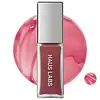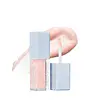What's inside
What's inside
 Key Ingredients
Key Ingredients

 Benefits
Benefits

 Concerns
Concerns

 Ingredients Side-by-side
Ingredients Side-by-side

Polybutene
Triisostearoyl Polyglyceryl-3 Dimer Dilinoleate
EmollientDiisostearyl Malate
EmollientOctyldodecanol
EmollientPolyglyceryl-2 Triisostearate
EmulsifyingC18-38 Alkyl Hydroxystearoyl Stearate
EmollientSilica
AbrasiveOpuntia Ficus-Indica Seed Oil
EmollientPalmitoyl Tripeptide-37
Skin ConditioningPalmitoyl Tripeptide-1
Skin ConditioningPalmitoyl Tripeptide-38
Skin ConditioningPortulaca Pilosa Extract
Skin ConditioningSqualane
EmollientEthylhexyl Palmitate
EmollientTribehenin
EmollientTocopherol
AntioxidantSucrose Cocoate
EmulsifyingTriethoxycaprylylsilane
Galactoarabinan
Caprylyl Glycol
EmollientCetearyl Ethylhexanoate
EmollientGlycerin
HumectantMalic Acid
BufferingLactic Acid
BufferingSorbitan Isostearate
EmulsifyingIsostearyl Alcohol
EmollientHexylene Glycol
EmulsifyingEthyl Vanillin
MaskingWater
Skin ConditioningIsostearic Acid
CleansingEthylhexylglycerin
Skin ConditioningSodium Sulfate
Phenoxyethanol
PreservativeCI 77491
Cosmetic ColorantCI 77891
Cosmetic ColorantCI 15850
Cosmetic ColorantCI 19140
Cosmetic ColorantPolybutene, Triisostearoyl Polyglyceryl-3 Dimer Dilinoleate, Diisostearyl Malate, Octyldodecanol, Polyglyceryl-2 Triisostearate, C18-38 Alkyl Hydroxystearoyl Stearate, Silica, Opuntia Ficus-Indica Seed Oil, Palmitoyl Tripeptide-37, Palmitoyl Tripeptide-1, Palmitoyl Tripeptide-38, Portulaca Pilosa Extract, Squalane, Ethylhexyl Palmitate, Tribehenin, Tocopherol, Sucrose Cocoate, Triethoxycaprylylsilane, Galactoarabinan, Caprylyl Glycol, Cetearyl Ethylhexanoate, Glycerin, Malic Acid, Lactic Acid, Sorbitan Isostearate, Isostearyl Alcohol, Hexylene Glycol, Ethyl Vanillin, Water, Isostearic Acid, Ethylhexylglycerin, Sodium Sulfate, Phenoxyethanol, CI 77491, CI 77891, CI 15850, CI 19140
Oleic/Linoleic/Linolenic Polyglycerides
EmollientBis-Diglyceryl Polyacyladipate-2
EmollientRicinus Communis Seed Oil
MaskingPolyhydroxystearic Acid
EmulsifyingCaprylic/Capric Triglyceride
MaskingButyrospermum Parkii Butter
Skin ConditioningPersea Gratissima Oil
Skin ConditioningEthylhexyl Palmitate
EmollientMica
Cosmetic ColorantOryza Sativa Bran Extract
Skin ConditioningSilica Dimethyl Silylate
EmollientCalcium Sodium Borosilicate
Oenothera Biennis Oil
EmollientVanillin
MaskingHelianthus Annuus Extract
EmollientCaprylyl Glycol
EmollientCitrus Aurantium Dulcis Peel Oil
MaskingEthylhexylglycerin
Skin ConditioningSilica
AbrasiveTribehenin
EmollientRosmarinus Officinalis Leaf Extract
AntimicrobialTocopherol
AntioxidantSorbitan Isostearate
EmulsifyingTrihydroxystearin
Skin ConditioningSodium Hyaluronate
HumectantPalmitoyl Tripeptide-1
Skin ConditioningGlucomannan
Skin ConditioningCitral
PerfumingLimonene
PerfumingLinalool
PerfumingCI 77891
Cosmetic ColorantCI 77491
Cosmetic ColorantTin Oxide
AbrasiveCI 45410
Cosmetic ColorantOleic/Linoleic/Linolenic Polyglycerides, Bis-Diglyceryl Polyacyladipate-2, Ricinus Communis Seed Oil, Polyhydroxystearic Acid, Caprylic/Capric Triglyceride, Butyrospermum Parkii Butter, Persea Gratissima Oil, Ethylhexyl Palmitate, Mica, Oryza Sativa Bran Extract, Silica Dimethyl Silylate, Calcium Sodium Borosilicate, Oenothera Biennis Oil, Vanillin, Helianthus Annuus Extract, Caprylyl Glycol, Citrus Aurantium Dulcis Peel Oil, Ethylhexylglycerin, Silica, Tribehenin, Rosmarinus Officinalis Leaf Extract, Tocopherol, Sorbitan Isostearate, Trihydroxystearin, Sodium Hyaluronate, Palmitoyl Tripeptide-1, Glucomannan, Citral, Limonene, Linalool, CI 77891, CI 77491, Tin Oxide, CI 45410
Ingredients Explained
These ingredients are found in both products.
Ingredients higher up in an ingredient list are typically present in a larger amount.
Caprylyl Glycol is a humectant and emollient, meaning it attracts and preserves moisture.
It is a common ingredient in many products, especially those designed to hydrate skin. The primary benefits are retaining moisture, skin softening, and promoting a healthy skin barrier.
Though Caprylyl Glycol is an alcohol derived from fatty acids, it is not the kind that can dry out skin.
This ingredient is also used as a preservative to extend the life of products. It has slight antimicrobial properties.
Learn more about Caprylyl GlycolCi 77491 is also hydrated iron III oxide. It's sole purpose is to give a red/pink hue to products.
Iron III oxides are classified as inorganic chemicals for coloring.
Synthetically created Ci 77491 is considered safer than those naturally found. This is because the synthetically created version may contain less impurities. Iron oxides are generally non-toxic and non-allergenic.
Learn more about CI 77491Ci 77891 is a white pigment from Titanium dioxide. It is naturally found in minerals such as rutile and ilmenite.
It's main function is to add a white color to cosmetics. It can also be mixed with other colors to create different shades.
Ci 77891 is commonly found in sunscreens due to its ability to block UV rays.
Learn more about CI 77891Ethylhexyl Palmitate, also known as octyl palmitate, is created from 2-ethylhexyl alcohol and palmitic acid. It is a fatty acid ester.
The fatty acid content of Ethylhexyl Palmitate makes it an emollient. Emollients help soften and hydrate your skin by trapping moisture within.
Ethylhexyl Palmitate is also used to help improve the texture of cosmetics. It helps other ingredient dissolve in products and help disperse ingredients more evenly.
You'll likely find this ingredient in sunscreen, as it is often used to mix UV-blocking ingredients such as avobenzone and ethylhexyl triazone.
It can also help stabilize the fragrances in a product as a fragrance fixative.
Ethylhexyl Palmitate can be used to substitute mineral oil.
Due to its high fatty acid content, it may not be fungal-acne safe.
Learn more about Ethylhexyl PalmitateEthylhexylglycerin (we can't pronounce this either) is commonly used as a preservative and skin softener. It is derived from glyceryl.
You might see Ethylhexylglycerin often paired with other preservatives such as phenoxyethanol. Ethylhexylglycerin has been found to increase the effectiveness of these other preservatives.
Palmitoyl Tripeptide-1 is also known as pal-GHK. It is made up of 3 amino acids and palmitic acid, a fatty acid that helps it absorb into skin more easily.
This peptide is as a signal peptide, meaning it tells the skin to produce more collagen. Collagen is the key protein that helps form the skin's structure and keep it plump, firm, and hydrated.
By boosting collagen production, this ingredient supports a stronger skin barrier and helps reduce the appearance of wrinkles.
You'll most likely see this ingredient paired with Palmitoyl Tetrapeptide-7 in the well-known Matrixyl 3000 complex. While results from in-house testing should be viewed cautiously, this peptide duo is among the most studied and widely used in modern skincare.
Due to its palmitic acid base, this ingredient may not be safe for Malassezia folliculitis.
Read more about other common types of peptides here:
Learn more about Palmitoyl Tripeptide-1Silica, also known as silicon dioxide, is a naturally occurring mineral. It is used as a fine, spherical, and porous powder in cosmetics.
Though it has exfoliant properties, the function of silica varies depending on the product.
The unique structure of silica enhances the spreadability and adds smoothness, making it a great texture enhancer.
It is also used as an active carrier, emulsifier, and mattifier due to its ability to absorb excess oil.
In some products, tiny microneedles called spicules are made from silica or hydrolyzed sponge. When you rub them in, they lightly polish away dead skin layers and enhance the penetration of active ingredients.
Learn more about SilicaSorbitan Isostearate is an emulsifer and cleaning agent. It is created from isostearic acid and sorbitol.
As an emulsifier, Sorbitan Isostearate prevents oils and water from separating.
Due to its isostearic acid base, it may not be safe for Malassezia or fungal acne.
Learn more about Sorbitan IsostearateTocopherol (also known as Vitamin E) is a common antioxidant used to help protect the skin from free-radicals and strengthen the skin barrier. It's also fat soluble - this means our skin is great at absorbing it.
Vitamin E also helps keep your natural skin lipids healthy. Your lipid skin barrier naturally consists of lipids, ceramides, and fatty acids. Vitamin E offers extra protection for your skin’s lipid barrier, keeping your skin healthy and nourished.
Another benefit is a bit of UV protection. Vitamin E helps reduce the damage caused by UVB rays. (It should not replace your sunscreen). Combining it with Vitamin C can decrease sunburned cells and hyperpigmentation after UV exposure.
You might have noticed Vitamin E + C often paired together. This is because it is great at stabilizing Vitamin C. Using the two together helps increase the effectiveness of both ingredients.
There are often claims that Vitamin E can reduce/prevent scarring, but these claims haven't been confirmed by scientific research.
Learn more about TocopherolTribehenin comes from glycerin and behenic acid.
It is used as an emollient, or moisturizer. Emollients form a thin barrier on skin to prevent moisture from escaping.
This ingredient may not be Malassezia folliculitis, or fungal-acne safe.
Learn more about Tribehenin